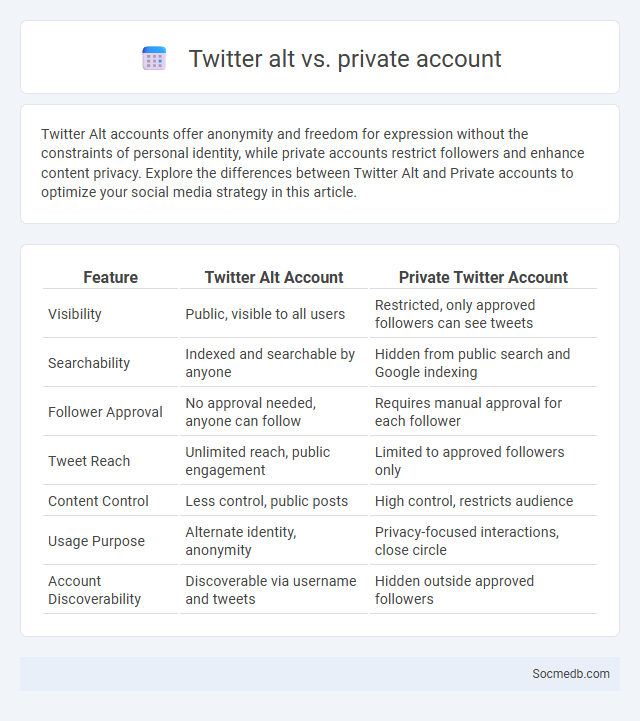
Photo illustration: Twitter Alt vs Private account
Twitter Alt accounts offer anonymity and freedom for expression without the constraints of personal identity, while private accounts restrict followers and enhance content privacy. Explore the differences between Twitter Alt and Private accounts to optimize your social media strategy in this article.
Table of Comparison
| Feature | Twitter Alt Account | Private Twitter Account |
|---|---|---|
| Visibility | Public, visible to all users | Restricted, only approved followers can see tweets |
| Searchability | Indexed and searchable by anyone | Hidden from public search and Google indexing |
| Follower Approval | No approval needed, anyone can follow | Requires manual approval for each follower |
| Tweet Reach | Unlimited reach, public engagement | Limited to approved followers only |
| Content Control | Less control, public posts | High control, restricts audience |
| Usage Purpose | Alternate identity, anonymity | Privacy-focused interactions, close circle |
| Account Discoverability | Discoverable via username and tweets | Hidden outside approved followers |
Understanding Twitter’s Account Types
Twitter offers several account types designed to meet diverse user needs, including Personal, Business, and Verified Accounts. Personal accounts cater to individual users for sharing thoughts and engaging with followers, while Business accounts provide tools for brand promotion, analytics, and advertising. Verified Accounts, marked by the blue checkmark, confirm authenticity and enhance trust, primarily benefiting public figures, brands, and organizations.
What Is a Main Account on Twitter?
A main account on Twitter refers to the primary profile a user employs for posting tweets, engaging with followers, and managing their online presence. This account typically features the user's real name, verified credentials, consistent branding, and serves as the central hub for interactions and content sharing. Maintaining a main account helps establish authenticity and credibility on the platform.
Defining Alt Accounts: Purpose and Use Cases
Alt accounts, short for alternative accounts, serve various purposes such as maintaining privacy, exploring different online personas, or managing separate professional and personal identities on social media platforms. These accounts allow users to engage in niche communities, avoid algorithmic biases, or test new content strategies without affecting their main profile's reputation. Understanding your intent behind creating an alt account helps optimize its use effectively while ensuring safer and more controlled social media interactions.
Exploring Private Accounts: Privacy and Control
Exploring private accounts on social media highlights the critical balance between user privacy and platform control mechanisms. Private accounts restrict content visibility to approved followers, enhancing user autonomy over shared information and reducing unauthorized access. These features empower individuals to curate their digital presence while navigating privacy settings that guard personal data against broader public exposure.
Key Differences: Alt vs Private Twitter Accounts
Alt Twitter accounts often prioritize anonymity, allowing users to share more candid thoughts without associating their primary identity, whereas private Twitter accounts restrict access exclusively to approved followers, emphasizing controlled privacy and selective interaction. Alt accounts foster open dialogue within niche communities or around specific topics, frequently embodying unconventional or experimental personas. Private accounts, in contrast, focus on trusted networks, enhancing user privacy and limiting content exposure to a chosen audience.
Reasons for Creating an Alt or Private Account
Creating an alt or private social media account allows users to maintain privacy while sharing content with a limited audience, protecting personal information from public scrutiny. Many individuals use alternative accounts to explore different interests, express opinions without judgment, or manage separate professional and personal personas. This approach also helps in avoiding algorithmic biases and targeted advertising by compartmentalizing online activity.
Pros and Cons: Main, Alt, and Private Accounts
Social media offers Main accounts for personal brand building, Alt accounts for exploring different interests anonymously, and Private accounts to control audience access and maintain privacy. Main accounts maximize visibility and engagement but may expose users to broader scrutiny and privacy risks. Alt accounts provide freedom to share diverse content without impacting personal reputation, while Private accounts limit follower access, balancing privacy with reduced reach.
Best Practices for Managing Multiple Twitter Accounts
Managing multiple Twitter accounts requires consistent scheduling to maintain active engagement across different audiences. Use social media management tools like Hootsuite or Buffer for streamlined posting and real-time monitoring, ensuring timely responses and effective content differentiation. Prioritize clear branding and separate content strategies to help Your accounts stay distinct and relevant to their specific followers.
Privacy and Security Considerations
Social media platforms require robust privacy settings to protect users' personal data from unauthorized access, ensuring compliance with regulations like GDPR and CCPA. End-to-end encryption and multi-factor authentication significantly enhance account security, reducing risks of data breaches and identity theft. Regular updates and user education on phishing scams and privacy controls are critical to maintaining a secure social media environment.
Choosing the Right Account Type for Your Needs
Selecting the appropriate social media account type is crucial for maximizing engagement and achieving specific goals. Business accounts offer advanced analytics, advertising options, and enhanced profile features ideal for brand promotion, while personal accounts provide a more casual, connection-oriented experience. Understanding your objectives and audience helps determine whether a creator, business, or personal profile best supports your social media strategy and growth.
 socmedb.com
socmedb.com